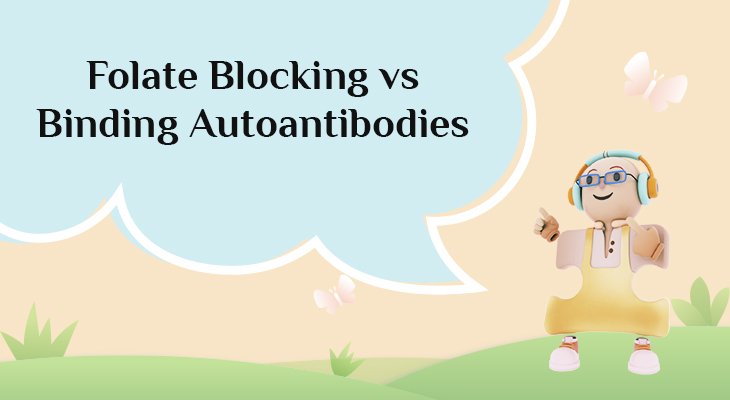
Folate Receptor Blocking Autoantibodies vs. Folate Receptor Binding Autoantibodies
Folate (Vitamin B9) is essential for numerous bodily functions, including DNA synthesis, repair, and methylation. Its efficient cellular uptake is primarily mediated by the Folate Receptor Alpha (FRα). The emergence of autoantibodies against this system is a significant clinical phenomenon, particularly linked to neurodevelopmental disorders like Cerebral Folate Deficiency (CFD) and autism spectrum disorders. However, a critical distinction exists between two types of autoantibodies: Folate Receptor Blocking Autoantibodies and Folate Binding Autoantibodies. This blog delineates their differences in mechanism, functional impact, clinical consequences, and diagnostic interpretation. The key differentiator is that folate receptor blocking autoantibodies specifically block the receptor, while folate receptor binding autoantibodies bind indiscriminately to the folate receptor itself, sequestering it and causing dysfunction of the receptor (often with an inflammatory effect).
To understand the difference, we must first understand the primary pathway of folate transport into critical systems like the central nervous system (CNS):
- Folate Receptor Alpha (FRα): A high-affinity receptor located on cell membranes, particularly abundant on the choroid plexus (the blood-CSF barrier). It binds folate and facilitates its transport into the brain via endocytosis.
- The Problem: Autoantibodies can develop that interfere with this process. Both blocking and binding folate receptor autoantibodies have similar effects in that they derailed proper folate transport into the cell, while the mechanisms of the autoantibodies are different. Both types of autoantibodies are detected in two distinct assays through the FRAT® test.
Detailed Comparison Table
| Feature | Folate Receptor Blocking Autoantibodies | Folate Binding Autoantibodies |
| Mechanism of Action | Bind directly to the folate-binding pocket of FRα. Physically block folate from attaching to the receptor. | Bind indirectly to folate receptor alpha, creating an immune complex. |
| Functional Consequence | Inhibits cellular uptake. Folate cannot enter cells (especially neurons and glial cells) despite normal blood levels. Creates a functional intracellular deficiency. | Sequesters folate. Renders folate biologically unavailable in circulation. Effectively reduces the amount of free, active folate. |
| Analogous Example | Blocking a keyhole. The key (folate) is present but cannot fit into the lock (receptor). | Handcuffing the key. The key (folate) is present but is bound and cannot be used. |
| Impact on CSF Folate | Markedly low. The blockade at the choroid plexus prevents transport into the cerebrospinal fluid, leading to Cerebral Folate Deficiency (CSF 5-MTHF < 40 nmol/L). | May be low due to reduced available folate for transport, but the primary defect is not a direct receptor blockade. |
| Clinical Association | Strongly linked to CFD and its associated conditions: • A subset of Autism Spectrum Disorder (ASD) • Regressive Autism • Neurological deterioration • Seizures • Movement disorders | Also linked to the same clinical symptoms |
| Treatment Implication | High-dose folinic acid (5-formyltetrahydrofolate) can often bypass the blocked receptor via alternative transporters (e.g., Reduced Folate Carrier – RFC). | May require very high doses of folate to saturate and create enough free folate for cellular uptake. |
| Diagnostic Interpretation | The pathologically significant antibody in the context of neurological CFD. Its presence (especially at high titers) is clinically actionable. | Same diagnostic interpretation |
Folate Receptor Blocking Autoantibodies
Pathophysiology: Folate Receptor Blocking Autoantibodies are highly specific IgG antibodies that attach to the FRα molecule at the exact site where folate is meant to bind. This is a classic example of a functional blocking antibody. The receptor is present and functional, but its activity is neutralized. This is particularly devastating for tissues that rely almost exclusively on FRα for folate uptake, such as the neurons of the developing brain.
- Clinical Presentation: The onset of symptoms is often in early childhood (e.g., 2-6 years old). Symptoms are neurological and can include:
- Regression of speech and motor skills
- Psychomotor retardation
- Seizures
- Ataxia and dystonia
- Insomnia and irritability
Folate Binding Autoantibodies (FBAAs)
- Pathophysiology: Folate Receptor Binding Autoantibodies bind to an antigenic site not involved in folate binding but can trigger an immune reaction and inflammation and render the receptor nonfunctional. Symptoms are consistent with systemic folate deficiency and also include:
- Regression of speech and motor skills
- Psychomotor retardation
- Seizures
- Ataxia and dystonia
- Insomnia and irritability
Coexistence of Folate Receptor Autoantibodies
It is common for patients to test positive for both types of antibodies. This can present a more complex clinical picture as the synergistic effect may create more of a dysfunction in folate metabolism. Standard blood tests can be misleading, as total serum folate might appear normal. Only the FRAT® test will detect the presence of folate receptor autoantibodies.
Diagnostic Testing
The most common method for detection of both blocking and binding folate receptor autoantibodies is the FRAT® test. Please consult your physician for more information. FRAT® requires a physician’s authorization.
Conclusion and Summary of Key Differences
While both Folate Receptor Blocking Autoantibodies (FRBAs) and Folate Binding Autoantibodies (FBAAs) disrupt folate metabolism, they are distinct entities with separate mechanisms and primary clinical consequences.
Understanding this critical distinction is essential for clinicians to accurately diagnose the root cause of a patient’s deficiency and implement the most effective, targeted treatment strategy.
Disclaimer:
This blog is for informational purposes only and not medical advice. Consult a healthcare provider for personalized recommendations. The FRAT® test is a lab developed test performed in a CLIA certified lab. FRAT® is NOT approved by the FDA and requires the authorization of a physician. Please consult your medical professional for more information.



